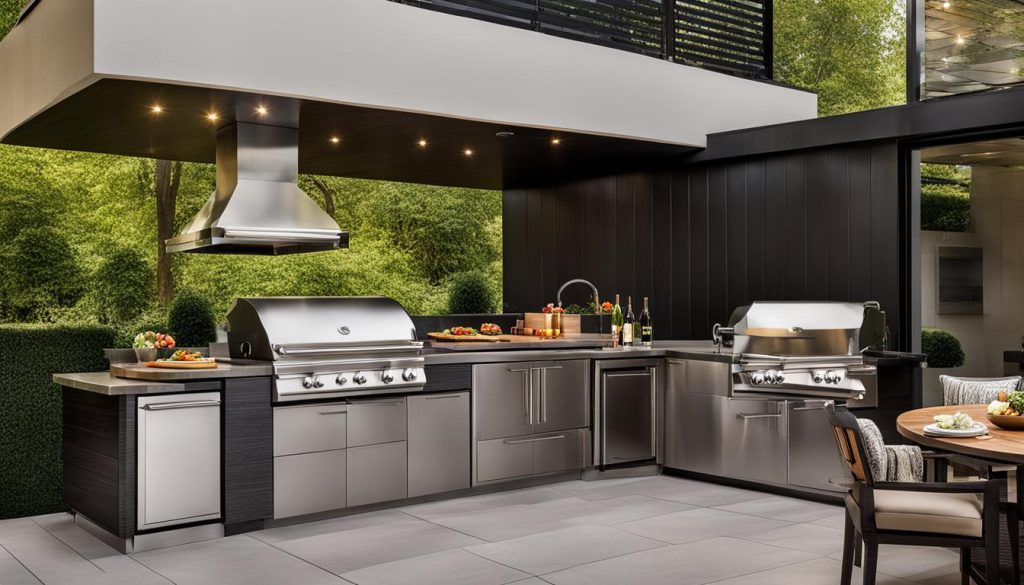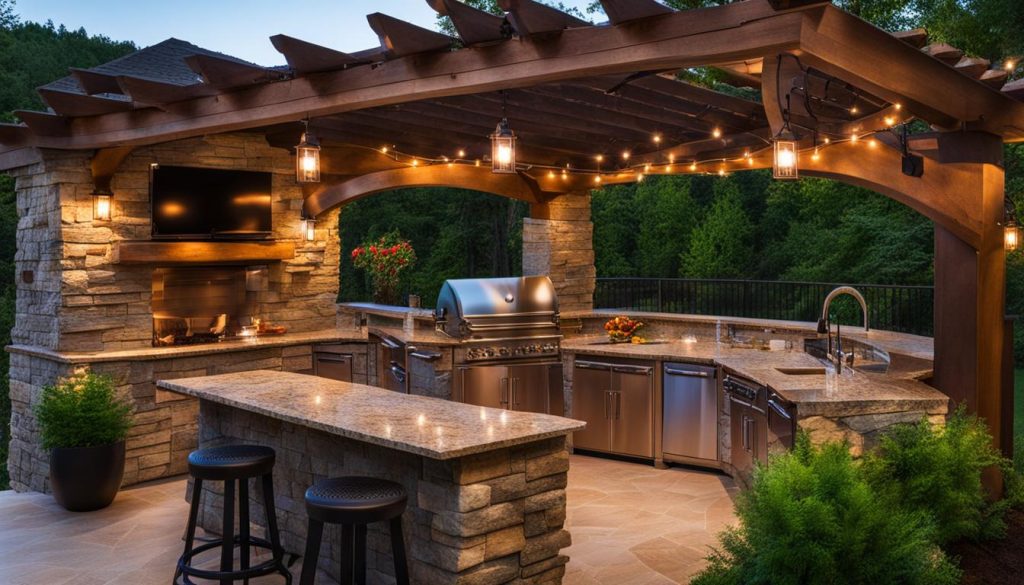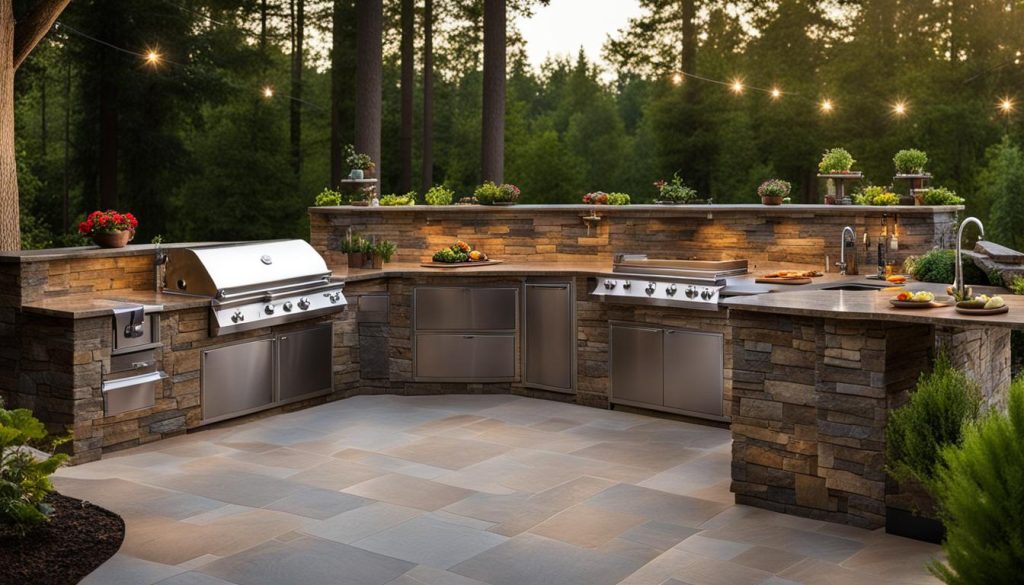Are you looking to create an outdoor cooking space that meets your unique needs and preferences? Our team has curated a variety of DIY outdoor kitchen projects that will inspire you to build the perfect cooking space in Canada. Whether you’re a seasoned DIYer or just starting, we’ve got you covered with innovative DIY outdoor kitchen ideas.
Key Takeaways:
- Creating a DIY outdoor kitchen is a fun and satisfying project.
- With proper planning and execution, you can build an outdoor cooking space that is functional and enjoyable.
- The Canadian climate requires specific materials and design considerations for outdoor kitchens.
- Outdoor cooking appliances and storage options are essential elements to include in your DIY outdoor kitchen.
- Your outdoor kitchen can be customized to your style preferences with the right design elements and materials.
Essential Elements for Your DIY Outdoor Kitchen
Undertaking a DIY outdoor kitchen project requires careful planning and execution. Apart from deciding on the design, you need to consider the essential elements that will make your outdoor cooking space functional and enjoyable. Here are some must-have features to include in your outdoor kitchen:
Outdoor Cooking Appliances
No outdoor kitchen is complete without cooking appliances. From grills to smokers and pizza ovens, there are various options to choose from depending on your preference and budget. Here are some popular choices:
| Appliance | Benefits |
|---|---|
| Gas or charcoal grill | Great for cooking BBQ meats and vegetables |
| Smoker | Allows you to cook low and slow for tender and juicy meats |
| Pizza oven | Perfect for making pizzas with a crispy crust and melted cheese |
Remember to consider the size and heat output of your appliances based on the number of people you will be cooking for and the types of meals you plan to prepare.
Storage Options
Having ample storage is essential to keep your outdoor kitchen organized and functional. Cabinets, shelves, and drawers are some storage options to consider. It’s also important to choose materials that can withstand the elements and are easy to clean.
Design Considerations
When designing your outdoor kitchen, consider factors such as accessibility, traffic flow, and safety measures. You may want to include a sink for washing and food prep, as well as a bar for entertaining guests. Make sure to incorporate adequate lighting so you can use your outdoor kitchen day or night.
By including these essential elements in your DIY outdoor kitchen, you can create a space that is both functional and enjoyable to use. Whether you prefer a simple setup or a more elaborate design, these features will help you build your dream outdoor cooking space in Canada.

Creative Design Ideas for DIY Outdoor Kitchens in Canada
Designing your outdoor kitchen in Canada involves making choices that suit your lifestyle and preferences while taking into account the local climate. Consider incorporating the following creative design ideas to personalize your DIY outdoor kitchen:
Materials
When selecting materials for your outdoor kitchen, it is essential to choose those that can withstand Canada’s harsh weather conditions. Stone, brick, and concrete are popular choices for outdoor cooking spaces in Canada as they are durable and can withstand extreme temperatures. Incorporating natural elements like wood and greenery can also create a warm and inviting ambiance in your outdoor kitchen.
Layout
The layout of your outdoor kitchen should be functional and practical. Consider creating different zones for cooking, prep work, and dining. This will ensure that your outdoor kitchen is organized and easy to use. You can also add an island or a bar for serving food and drinks, which can double as a focal point for your outdoor cooking space.
Lighting
Good lighting is essential for any outdoor kitchen, especially in Canada where daylight is limited during the winter months. Consider installing task lighting over the cooking and prep areas to ensure you can see what you are doing. You can also add ambient lighting to create a warm and inviting atmosphere in the evenings.
Colour Scheme
Choosing the right colour scheme for your outdoor kitchen can create a cohesive and inviting space. Consider incorporating earthy tones to complement the natural surroundings. Bright pops of colour can also add a fun and playful vibe to your cooking space. Make sure to choose colours that are resistant to fading and weathering.
| Design Element | Idea |
|---|---|
| Fireplace | Install a fireplace to provide warmth and create a cozy ambiance during colder months. |
| Water Feature | Add a water feature like a fountain or small pond to create a tranquil and relaxing atmosphere. |
| Artwork | Add artwork to your outdoor kitchen to create a unique and personalized cooking space. |

Conclusion
Designing your DIY outdoor kitchen in Canada can be a fun and rewarding project that adds value to your home. By incorporating creative design ideas that reflect your style and personality, you can create an outdoor cooking space that is both functional and inviting. Consider the local climate and materials when planning your project, and don’t forget to add personal touches like artwork or a water feature to make your outdoor kitchen truly your own.
Tips for Successful DIY Outdoor Kitchen Projects
Undertaking a DIY outdoor kitchen project can be a fulfilling and rewarding experience. However, to ensure the success of your project, there are key considerations that you need to keep in mind. Here are some valuable tips that will help you build a functional and long-lasting outdoor cooking space:
1. Choose the Right Location
The location of your outdoor kitchen is crucial for its functionality and convenience. Consider factors such as the prevailing wind direction, access to water and electricity, and proximity to your indoor kitchen. You want to ensure that your outdoor kitchen is easily accessible and has sufficient space to accommodate your equipment and guests.
2. Select Suitable Materials
The materials you choose for your outdoor kitchen should be durable, weather-resistant, and easy to maintain. Consider materials such as stainless steel, stone, and concrete, which are suitable for the Canadian climate and can withstand the elements. You also want to choose materials that complement the style of your home and landscape.
3. Plan for Proper Ventilation
Proper ventilation is essential for your outdoor kitchen, especially if you’ll be using a grill or smoker. Adequate ventilation will prevent smoke buildup and keep your kitchen safe and comfortable. Be sure to include a hood or exhaust fan in your design and consider the placement of your cooking equipment.
4. Incorporate Storage and Counter Space
Storage and counter space are essential elements of any functional kitchen, and your outdoor kitchen is no exception. Incorporate cabinets, drawers, and shelves to store your cooking equipment, utensils, and supplies. Ensure that you have sufficient counter space for food preparation, serving, and entertaining.
5. Follow Proper Safety Measures
Building an outdoor kitchen requires following proper safety measures to avoid accidents and injuries. Be sure to follow building codes and regulations, especially for gas lines and electrical wiring. Install fire extinguishers and smoke detectors in your outdoor kitchen, and educate yourself on gas grill safety guidelines.
6. Plan for Maintenance
Maintaining your outdoor kitchen is crucial for its longevity and functionality. Plan for routine maintenance, including cleaning your equipment, inspecting gas lines, and assessing any wear and tear. Consider covering your outdoor kitchen during the off-season to protect it from the elements and extend its lifespan.
By following these tips, you can successfully build a DIY outdoor kitchen that meets your needs and enhances your outdoor living space.
Are you considering an outdoor kitchen but unsure where to begin? Our expert designers are eager to meet with you, understand your must-haves, and capture your unique style. Renowned in Toronto and the GTA, Outdoor Kitchens stands out for using top-notch materials, seasoned contractors, and a prolific design team to bring your vision to life. Feel free to get in touch with us! Whether you have questions, need assistance, or want to discuss your project, our team is here for you.
FAQ
Do I need any special skills to build a DIY outdoor kitchen?
Building a DIY outdoor kitchen does require some basic knowledge of construction and plumbing. However, with the right resources and guidance, anyone can successfully complete a project. It’s important to research and plan before starting and seek professional assistance when needed.
What are the essential elements I should include in my DIY outdoor kitchen?
The essential elements for your DIY outdoor kitchen include a grill or cooking appliance, a work surface or countertop, storage options such as cabinets or shelves, a sink or water source for convenience, and comfortable seating or dining area. These elements will ensure your outdoor cooking space is functional and enjoyable.
How can I personalize my DIY outdoor kitchen design?
You can personalize your DIY outdoor kitchen design by choosing materials and styles that reflect your personal taste. Consider incorporating unique features such as a pizza oven, outdoor bar, or custom lighting. Adding decorative elements like plants, artwork, or outdoor rugs can also enhance the ambiance of your cooking space.
Are there any safety precautions I should take when building an outdoor kitchen?
Yes, when building an outdoor kitchen, it’s important to prioritize safety. Ensure all electrical and gas connections are done by professionals to avoid potential hazards. Use appropriate materials that are resistant to outdoor elements and follow proper ventilation guidelines. Additionally, install fire safety measures such as fire extinguishers and smoke alarms.
How much does it cost to build a DIY outdoor kitchen?
The cost of building a DIY outdoor kitchen can vary depending on the complexity of the project and the materials used. It is recommended to set a budget before starting and to research the prices of appliances, materials, and labor. DIY projects can help save costs, but it’s important to factor in any additional expenses such as permits or professional assistance if needed.
How do I maintain and protect my DIY outdoor kitchen?
To maintain and protect your DIY outdoor kitchen, regular cleaning is essential. Clean cooking surfaces, countertops, and appliances after each use to prevent the buildup of grease and dirt. Cover or store outdoor furniture and appliances when not in use to protect them from the elements. Regularly inspect for any damage or wear and make necessary repairs promptly.

